Rehabilitated penguins
Olivia – the feisty lady penguin.
Vila decided to take a closer look… and the bird didn’t move, on closer inspection she noticed it had a completely white eye. She thought maybe it had been hit by floating debris from a big flood we had 2 days before and was blind in that eye. She decided to bring it to me - the main rehabber for the Helps Pōhatu Conservation trust – where our new DoC permitted rehab area has been set up in our backyard.
I was in the middle of cooking dinner when Vila arrived with the penguin, she said it was pretty feisty, and bit her several times while putting it in the bucket (the only thing she had on hand at the time to carry it in).
I turned off the stove, cooking aside and took a look. She bit me (the penguin not Vila) and struggled, and I noticed it had a hot swollen foot. Hot swollen feet on a penguin is not good. Not good for anyone really, but for a penguin it can mean infection which can sometimes develop to a bone infection and it can be very hard to recover from.
It was getting late so I messaged Pauline - the penguin vet in Christchurch - letting her know I was coming in with a penguin in the morning. I also thought it was blind in one eye and thought it might have to live out it’s days at the International Antarctic Center as an advocate… if it survived.
I made Miss penguin comfortable for her overnight stay, lots of towels so she could snuggle down and take pressure off her bad foot. She repaid me with a snip and a bite. Vila said good luck (in a good riddance kind of tone). Pleased to have nothing more to do with the situation.
In the morning I loaded her into the van, feisty as ever with her bad eye and swollen foot.

|
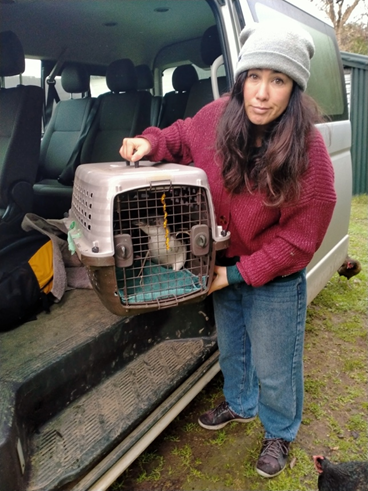 |
We made it to the vet clinic - Willowbank wildlife hospital, a one-and-a-half-hourdrive. Pauline was actually away on holiday but had arranged for another vet to come in for our feisty friend. Pauline is one of the only penguin vets in Canterbury, so, ever volunteering for our wildlife - she had to video conference while the other vet performed the surgery. It wasn’t looking good, turn out miss feisty had lacerations from a small shark and the wounds were infected. But guess what? With the amazing veterinarian skills, they pulled her through.
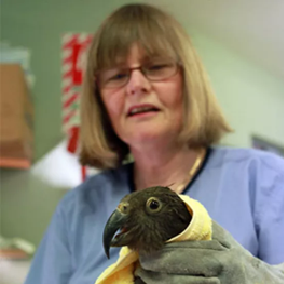 Pauline the penguin vet at Willowbank wildlife Hospital with a Kea. |
I was amazed to hear feisty had survived a shark attack!... Or maybe that Shark had survived a penguin attack? The penguin was named Olivia, no idea why, but Pauline continued to look after her once she got back from holiday. Olivia’s eye came right, she wasn’t blind! Pauline was also amazed - thinking she probably wouldn’t survive, but she did and soon became one of her favorite penguins of all time - due to her feisty nature and will to survive. |
| Olivia moved into the expert care of Kristina and Thomas (Christchurch penguin Rehab) for the next steps in recovery. In winter, they care for penguins in their well set up garage/ rehab center. Olivia got to practice walking around on her now healed legs, she had some freedom to roam the garden but her favorite spot was the sunny garage window. |
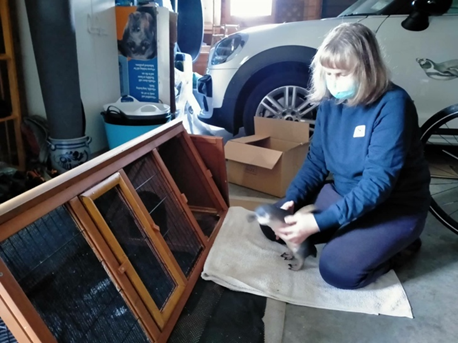 Kristina and Olivia the penguin. Kristina and Olivia the penguin. |
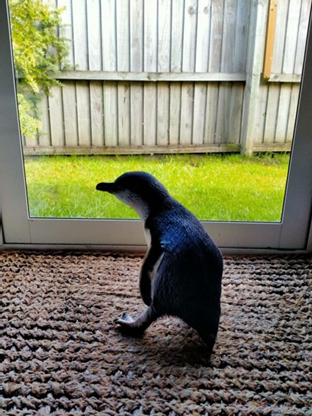 |
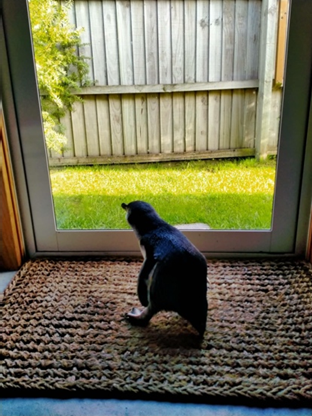 |
After a few weeks, it was time for me to come back and get her, she was ready to go home. I drove to Christchurch, did some much-needed shopping, then last stop, picked up Olivia.
| But unfortunately, the carry cage I had brought her in when I first dropped her off to the vet was left at the wildlife hospital, all the way over the other side of town. Kristina had a good selection of boxes. We picked the biggest one there was and pegged a towel over the top, so Olivia would feel nice and calm for the drive… I thought. I sat the box on the passenger seat beside me. It was all good, until I was just coming out of the city. Olivia started trying to make a break for it. I could see the towel bobbing up and down. Then a peg pooped off… and then another, a penguin head popped out of the opening. She gave me a look of contempt and then went back to her escape effort. |
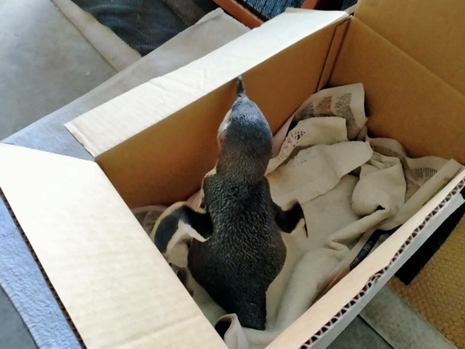 We taped the box lids higher and pegged a towel over the top. |
I could hear her claws scratching the inside of the box. She was using her beak and head, levering herself up by her chin. I freaked out, I would soon have a penguin running around the van with me, biting my ankles and getting under the foot pedals.
I pulled over on the highway, moved all my shopping around the back, making a barrier between me and the penguin and tightened the towel on top of her box. She growled at me and tried to peck me but luckily for the rest of the drive stayed put.
It was late by the time I got home. I live in Akaroa and Pōhatu is another 45-minute drive. So, I planned to go in the morning, Olivia would spend the night in our penguin rehab center. Kristina had given me some fresh baby Salmon to feed her. I wasn’t looking forward to that experience… and I was right not to. She almost ate my fingers off.
Unfortunately, our rehab area is built just outside our bedroom window… And Olivia, being a penguin was very vocal and active all night. In summer I get use to penguin sounds, but it was winter and we don’t normally have penguins in rehab this time of year. I could hear her calling, jumping, scratching and digging. Thank goodness we have a pretty hardcore enclosure, she was in a hutch, within a bigger mosquito proof enclosure - with a locked door, within a bigger enclosure surround by deer fencing and chicken wire. Fort knocks for penguins you could say. They are really clever birds that are amazing climbers, and great at digging tunnels. I’ve never been so worried about a penguin escaping before – she had me checking on her late at night, my anxiety high from her previous highway escape.
Next morning, she’s there. Looking up at me like… What? Bright eyed and bushy tailed (well as much as a penguin can be bushy tailed).
I had a good carry caged this time for the trip to Pōhatu.
She was actually well behaved this time, seemed a bit like she knew what was going on.
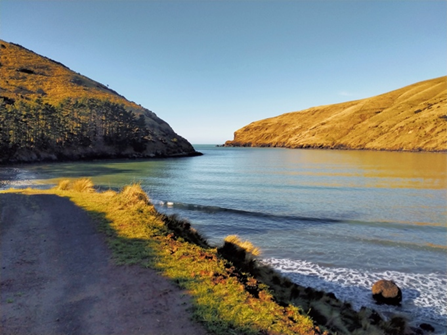 |
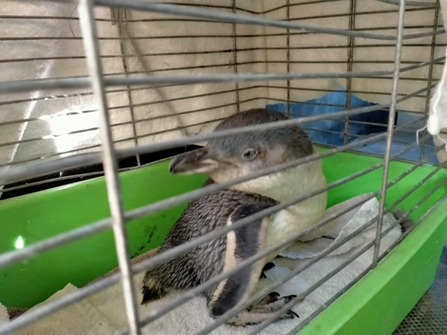 |
We got to the bay, it was one of those glorious sunny winters’ morning. The sea flat and clear. No giant petrels to be seen (which is a natural predator for penguins), ideal for penguins relaxing in the bay.
I swear she heard the lapping of the waves when I opened up the van door. She started jumping around and scratching in the cage. Ok, hard release it is. Normally we put rehabbed birds in a soft release box on the beach – so we can check on them, feed them if they don’t go and they can choose to go when they are ready… But Olivia was ready.
I put the cage on the beach, opened up the lid and gently tipped it over, hands clear. She promptly jumped out and nonchalantly waddled straight to the sea. She dove under the first small wave, popped up, swam around a bit on the surface, drank some sea water and with the next wave dove under and took off like an underwater missile, leaving a streamlined wake into the big blue. No looking back, no thanks for saving my life.
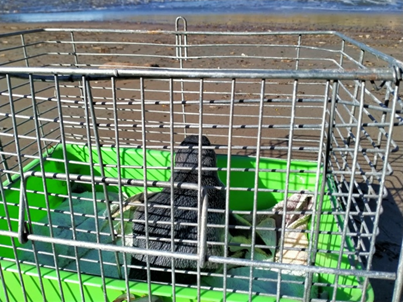 |
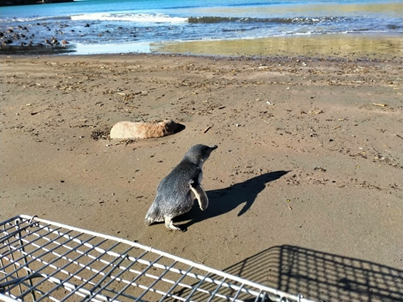 |
She had been given a microchip. So, if we find her on our monitoring rounds it’s going to feel bloody good. It’s right on the time of year they start nest building, and my hope is Olivia finds her partner and gets settled for the season.
Older birds are worth rehabbing, these are the experienced birds at raising chicks, it can take some time to learn how to be a good parent.
You get all kinds of penguins through rehab, some are just the timidest gentle souls, some grumpy, some chilled out, but when you get a feisty penguin like Olivia, you just know with their survival instinct and tenacity they are probably at the top of the pecking order and super penguins to have leading the colony.
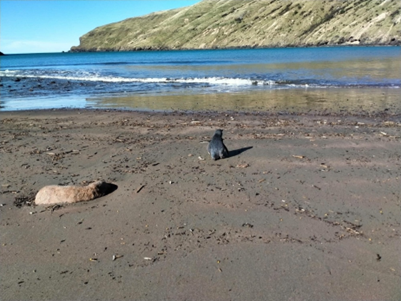
DoC licensed Penguin Rehabber for the Helps Pōhatu Conservation Trust.
|
Ideally, we don’t want to handle our penguins at all. However, some of them need our help whether it be from an injury, illness or malnourishment. Pohatu Penguins steps in and gives these little birds a second chance at life! Most of our rehabilitated penguins are underweight or malnourished chicks. Typically, we find these chicks during our tours as we monitor the nesting sites. Why are the chicks malnourished/underweight?
What do you do in rehabilitation? This depends on the penguins needs and condition. Typically we will feed them 2-3 times a day depending on their weight and age. If they are old enough we will bring them for a swim in our “swim therapy pool”. Here, we introduce them to the water and determine if they are ready to be released. Injured or sick penguins will be sent to either a specialized penguin vet or dedicated specialists, Kristina and Thomas*, in Christchurch where they are assessed for future placement. Permanently injured penguins have the chance to live out their lives at the Antarctic Centre. *K&T Link: https://www.stuff.co.nz/environment/88518082/christchurch-couple-give-injured-rescue-penguins-the-full-pamper-treatment ParniaI spotted Parnia while kayaking; she was standing on the rocks looking extremely thin and weak. After getting back onto shore I quickly grabbed a bucket and went on to retrieve her – she gave little resistance to capture. Once I saw her up-close I realized that she had a deformed beak, probably why she had been so thin. (It’s very difficult for penguins to hunt efficiently with a crooked beak, most die.) I had never seen such a thin penguin and I expected her to die within the day, but still it was worth a shot to try and save her. Penguin band: P 41 087One year a starvation event happened right in the middle of the breeding season. When starvation occurs parents stop feeding their chicks to save themselves or only do so periodically. Chicks are then forced to leave (or fledge) the nest early in search of food. Unfortunately, chicks under 8 weeks old are not properly equipped to survive at sea and either starve or drown. In order to prevent early fledgings I fed the chicks while they remained in their burrows, hoping that the starvation event would end soon. Slowly but surely the parents started to return consistently feeding their youngsters and relieving me of my duties! Two years later P41 087 (we used to band our penguins) turned up in one of my breeding boxes. He was one of the largest, most beautiful penguins I had ever seen. P41 087 was evidence that my feedings, two years ago, had been a success. It warmed my heart to know that I helped save this little penguin and build him up for a healthy, successful life in the wild. He was my pride and joy. RoxyRoxy was handed in by the Fox II, a tourist sailing boat in Akaroa. She was extremely thin with a severe injury to her eye. Roxy looked like a recently fledged chick that seemed to have been hit by a boat. Her condition was very grim and I had my doubts about her survival.
However, to my delighted surprise she survived the first 24-hours, then the next and the next, and by day 3 she was on the road to recovery! Her eye injury, however, would be permanent and she would never be able to see from it again. Although, she was doing well in rehabilitation we knew that she wouldn’t stand a chance in the wild, thankfully, Roxy was also sent to the Antarctic Centre where she’ll live out a long and luxurious life! Shark baitThis is an all time favorite story that demonstrates incredible intelligence – intelligence you would never expect from a penguin. One night, while running an Evening Penguin Tour, we found a horribly injured penguin beside the track. I immediately took him into care and the next morning rushed him to Christchurch for an emergency veterinary assessment.. He had several shallow, flesh wounds and a lacerated leg. We suspected the culprit had been a shark. The vet stitched him up and I took him home to recover.. He spent a few weeks with us recovering and eating lots of fish – something he was quite happy to do through his moult*! Once his moult was complete we returned him to the sea and he happily shot off like a rocket! One year later, while running a tour, in the same spot on the tarck out in the open, we found a penguin near the track and out in the open we found a penguin that did move away from us as he should. He also did not attempt to bit and was very relaxed when I picked him up to examine him to find an explanation for this strange behaviour. He was in very good condition, but lame in one leg as Shark bait was when we released him. He proved beyond doubt who we was when I tried to feed him. He snapped and gulp the fish down gleefully and then looked for more, greedy as ever. As he was looking forward to another free easy loading molt we decided to indulged him and sent him on his way, fat and sleek once his feathers were grown in. Once again he shot off, instantly a wild penguin, but we did wonder, would he be back next year for another easy moult*? *Little Penguins moult – loose their old feathers and grow new ones – for two weeks every year. During the moult they cannot hunt and thus starve until it is complete. Yappy WiggleThis was the funniest penguin I’ve ever cared for! One day, while monitoring nesting sites I came across a burrow with one healthy chick and one very small runt. If one chick gets too far behind they simply die and the fouled nest can cause the healthy chick to become sick and die. The best option was to take the runty chick out, but then what to do with it? I decided I would simply throw it in the bushes. It’s very difficult to raise chicks that are less than 2 weeks old, especially if they are runts, but I thought I’d give it a go. Trying to feed such a young chick was not easy, but the little guy responded well and started to put on weight. Soon enough he turned into a healthy, respectable penguin. He became far too tame, however, and ran around like a puppy dog, wiggling his tail and begging for food with sharp, yapping noises. When it came time for him to leave he wasn’t exactly keen. On the first release he returned the next day yapping his way up the drive, begging for more fish. He had obviously not found any for himself. I allowed him to stay for a few days until I figured that we better try again; so, for a second time we released him back into the wild. He returned the very next day for more fish. I fed him once more and came up with a new idea, we’ll release him by kayak! So, in our third release, we took him by kayak to the entrance of Flea Bay and let him go. This seemed to be successful until the fifth day when we saw him hobbling towards the house. This time he was much weaker, thinner and a bit injured. I assumed he had hurt himself along the rocks and barnacles while exiting the sea. After our third try, we realized that Mr. Yappy Wiggle had imprinted on us and would not succeed in the wild. He now happily resides in the Antarctic Centre yapping and wiggling all over the place! Our Christmas Eve SagaBefore you read this you must understand: Yellow Eyed Penguins are the rarest penguin in the world and are extremely endangered. Every single one is precious. One Christmas Eve during a penguin tour we saw one of our Yellow Eyed Penguins drag itself ashore, obviously injured and bleeding. We caught the Yellow Eyed to gauge its injuries in which its feet were badly cut. It looked as though it kicked itself free from the jaws of life and escaped a near death shark attack. It needed stitching as soon as possible if it was to survive, but what vet would be open on Christmas Eve or Christmas Day? Talk about bad timing. I rang our closest vet in Little River and to my surprise he said to bring it straight over. This was 10.00pm on Christmas Eve. We arrived in Little River at 11.30pm, but the vet was nowhere to be seen. We sat there waiting and silently panicking over this precious penguin’s life. Until suddenly a vehicle pulls up with the vet and vet’s family! In order to successfully and painlessly stitch the penguin he needed to be put under. However, this can be dangerous if the penguin has a full stomach – something we weren’t sure about. We simply had to hope for the best and move forward with the procedure. The penguin did not fair well with the gas, he kept drifting in and out of conscious. Then, suddenly he started to heave and projectile vomit fish across the table, the floor and even the walls! Now, you can imagine our surprise, you can also imagine that it was quite unexpected and unfortunately we did not have time to react. So, like the table, the floor and the walls, we too were covered in fish vomit. Merry Christmas indeed! Thankfully after loosing its stomach contents our Yellow Eyed Penguin drifted into sleep and the vet was able to finish the job. With stitched and bandaged feet we placed our groggy penguin back into our vehicle. As we had to get the penguin home our vet and his family had to clean up the fish vomit – lucky them! We bid farewell and wished our Christmas heros a very Merry Christmas. After Christmas I sent the penguin to Christchurch to my wonderful friends and penguin rehab specialists, Christina and Thomas. Once it healed properly we released our Christmas penguin back into the wild. |
 Feeding chicks Feeding chicks Rehabilitated penguins in our garden going for a walk  Swim! (allow the penguins to oil up their feathers)  Releasing an adult.  Two chicks ready to go! (White flippered and Little Blue)  Trying to release Yappy Wiggle.  Still trying to release Yappy Wiggle...  Yellow Eyed Penguin with stitched foot.    |
|
These are just a few of the more memorable birds we have had in care. We rehabilitate many penguins, mostly Little Penguins, sometimes Yellow Eyed and occasionally a Crested Penguin. Most are sent off to sea successfully! If you too wish to help visit our Adopt a penguin page. |


Comments